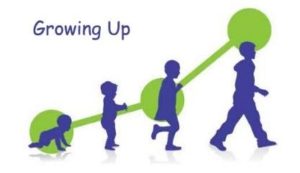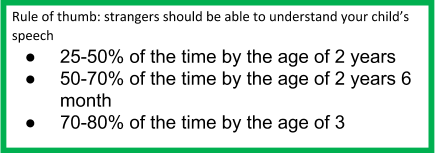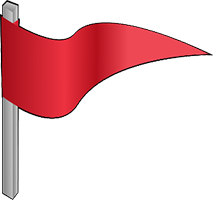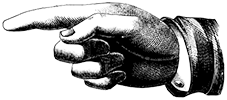Speech clarity is what we use to refer to a child’s pronunciation of words.
- Can you understand what he is telling you? What about if you don’t know what he’s talking about – can you understand him?
- Can you understand him, but less familiar people – aunty, teacher, shopkeeper – struggle?

So, what is normal?
Talking starts a lot earlier than many people think. Between three to five months, infants should be cooing, gurgling and making playful sounds. Around six months old they are making more speech-like sounds (like ma, ba, da); and by year one they should be babbling strings of sounds together (like baba, dada).

Weiss, CE (1982). Weiss Intelligibility Test. Tigard, OR: CC. Publications.
Here is a helpful chart you can refer to that highlights what ages we would expect certain speech sounds to develop, and so help you decide whether or not to be concerned about your child’s speech development:
Typical Development of ENGLISH Sound Sounds
*Children learning more than one language may develop some sounds earlier OR later
| Age 75% of children use the sound accurately. | Speech sounds |
| By 3 years | h, zh (as in measure) y, w m, n, ng (as in sing) p, b t, d k, g (as in go) |
| 3 years 6 months | f |
| 4 years | l sh ch |
| 4 years 6 months | j as in jaw s, z |
| 5 years | r |
| 6 years | v |
| 8 years | th as in this |
| 8 years 6 months | th as in thing |
Bowen, C. (2011). Table4: Phonetic Development. Retrieved from http://www.speech-language-therapy.com/ on 20 December 2019.
Just to confuse you further, while children are learning sounds they tend to make speech sound error patterns. We call these phonological processes. Here is a table of these processes and when they are typically gone by.
Elimination of Typical Phonological Process in English
| PHONOLOGICAL PROCESS | EXAMPLE | GONE BY APPROXIMATELY |
| Pre-vocalic voicing | pig = big | 3;0 |
| Word-final de-voicing | pig = pick | 3;0 |
| Final consonant deletion | comb = coe | 3;3 |
| Fronting | car = tar ship = sip | 3;6 |
| Consonant harmony | mine = mime kittycat = tittytat | 3;9 |
| Weak syllable deletion | elephant = efant potato = tato television =tevision banana = nana | 4;0 |
| Cluster reduction | spoon = poon train = chain clean = keen | 4;0 |
| Gliding of liquids | run = one leg = weg leg = yeg | 5;0 |
| Stopping /f/ /s/ | fish = tish soap = dope | 3;0 |
| Stopping /v/ /z/ | very = berry zoo = doo | 3;6 |
| Stopping ‘sh’ ‘j’ ‘ch’ | shop = dop jump = dump | 4;6 |
| Stopping ‘th’ | thing = ting them = dem | 5;0 |
Bowen, C. (2011). Table 3: Elimination of Phonological Processes. Retrieved from http://www.speech-language-therapy.com/ on 20 Dec 2019
Types of Speech Disorders and Possible Causes
Terms may differ slightly, but overall possible types of speech disorders include:
- Speech / phonological delay: following the typical speech sound development, but slower than expected
- Articulation disorder: difficulty with particular speech sounds (e.g. lateral slushy lisps)
- Phonological disorder: unusual / disorder speech sound processes (error patterns) (e.g. missing out the beginning consonants of words, like ‘o’ for go)
- Inconsistent speech sound disorder: inconsistent production of sounds in or across words
- Dysarthria: a speech disorder impacted by muscle weakness – https://www.asha.org/public/speech/disorders/dysarthria/
- Childhood apraxia of speech: a motor speech disorder wherein “the brain has trouble sending messages to the speech muscles telling them how and when to move” – https://www.asha.org/public/speech/disorders/Childhood-Apraxia-of-Speech/
It is not always clear what causes the speech difficulty in children. Children may have speech difficulties if they have had or have a:
- Hearing loss – even temporary from ear infections over an extended period of time
- Brain damage (e.g. head injury, cerebral palsy)
- Developmental disorders (e.g. autism, global developmental delay)
- Genetic syndrome (e.g. Down Syndrome)
When should I be concerned?

- Your child is not talking, or not copying sounds
- Your child is hard to understand (by age 2 you should understand about half of what they are saying; by age 4, unfamiliar listeners should understand at least 66% of what they are saying)
- Your child is making the above error patterns when they shouldn’t be
- Your child is making sound errors that are not listed above, which suggests they could be making atypical / unusual error patterns – for example, mixing up or using incorrect vowels
| 1–2 years old | Not saying p, b, m, h, and w the right way in words most of the time |
| 2–3 years old | Not saying k, g, f, t, d, and n the right way in words most of the time. Being hard to understand, even to people who know the child well. |
Taken from: https://www.asha.org/public/Early-Identification-of-Speech-Language-and-Hearing-Disorders/ on 20 Dec 2019
What are the different types of speech sound difficulties?
Terms may differ slightly, but overall possible types of speech disorders include:
- Speech / phonological delay: following the typical speech sound development, but slower than expected
- Articulation disorder: difficulty with particular speech sounds (e.g. lateral slushy lisps)
- Phonological disorder: unusual / disorder speech sound processes (error patterns) (e.g. missing out the beginning consonants of words, like ‘o’ for go)
- Inconsistent speech sound disorder: inconsistent production of sounds in or across words
- Dysarthria: a speech disorder impacted by muscle weakness – https://www.asha.org/public/speech/disorders/dysarthria/
- Childhood apraxia of speech: a motor speech disorder wherein “the brain has trouble sending messages to the speech muscles telling them how and when to move” – https://www.asha.org/public/speech/disorders/Childhood-Apraxia-of-Speech/
It is not always clear what causes the speech difficulty in children. Children may have speech difficulties if they have had or have a:
- Hearing loss – even temporary from ear infections over an extended period of time
- Brain damage (e.g. head injury, cerebral palsy)
- Developmental disorders like autism, global developmental delay
- Genetic syndrome (e.g. Down Syndrome)
What can I do to help?
If you have a baby or toddler, play with sounds! Babble with them, encourage them to copy you, make fun sounds while you play
e.g. Animal noises – exaggerate and make them repetitive and fun
Single sounds paired with routine actions, like “Mmmmm” eating
Repetitive sounds with playful actions, like “Fffeee fffie fffoe fffum!”
Sound effects, like “eewoo eewo eewo” ambulance, “buda buda” drumBe face to face when you make and model these sounds. You can give tips on how to make the sound, but DON’T PUT PRESSURE ON YOUR CHILD TO COPY:
e.g. “Lets round our lips like this, oooooo”
“Can you make bunny teeth? F-f-f.”Repeat back what your child has said, slightly slowing down and emphasizing the correct pronunciation
- Break long words up into syllables – clap or tap them out, especially important / meaningful words like family names
- Be face to face so your child can model
If you just can’t get what your child is saying:
- Ask them to repeat what they said – if they won’t get frustrated, “I didn’t hear what you said, can you say that again?” “Can you say that more slowly?
- Ask them to tell you or show you in another way, “Sorry my ears aren’t working well today.”
AVOID:
- Correcting your child or forcing them to copy you multiple times – keep your interactions fun and meaningful
- Modelling ‘baby talk’ that involves changing or missing out sounds (e.g. calling a banana ‘nana’ because it sounds cute when your child says it)
Written by:
Ezmi Brits BSLT, MNZSTA
Speech and Language Therapist
Cornerstone Therapy


 If you have a baby or toddler, play with sounds! Babble with them, encourage them to copy you, make fun sounds while you play
If you have a baby or toddler, play with sounds! Babble with them, encourage them to copy you, make fun sounds while you play Be face to face when you make and model these sounds. You can give tips on how to make the sound, but DON’T PUT PRESSURE ON YOUR CHILD TO COPY:
Be face to face when you make and model these sounds. You can give tips on how to make the sound, but DON’T PUT PRESSURE ON YOUR CHILD TO COPY: Repeat back what your child has said, slightly slowing down and emphasizing the correct pronunciation
Repeat back what your child has said, slightly slowing down and emphasizing the correct pronunciation If you just can’t get what your child is saying:
If you just can’t get what your child is saying:




